-

人教版新目标初中英语九年级上册I like music that I can dance to教案
教学目标: 1. Express preferences2. Talk about one’s likes and dislikes and the reasons3. Learn to express one’s opinions 4. Learn to write a reply 语言功能: 1) Talk about one’s preferences, using t he relative clause2) Talk about people’s likes and dislikes and the reasons3) Talk about opinions语言结构: Relative clauses with that and who语言目标:What kind of music do you like?I like music that I can sing along with.I love singers who write their own music.We prefer music that has great lyric.重点词汇及短语:heart, photography, interest, class, whatever, miss, okay, expect, sweet, taste, itself, laboratory, cancer, increase, biscuit, main, care, prefer… to…, remind somebody of …, dance to, sing along with, be sure to, interest somebody, make somebody adj., to be honest, suit somebody, on display, catch up教学重难点:What do other people think of the different kinds of things? How to express one’s opinions? 学习方式:讨论,合作学习情感目标:通过本单元的学习,能提高学生的艺术鉴赏能力和审美情趣,并引导学生养成健康的饮食习惯。课时安排5课时第一课时:Section A: 1a-2c第二课时:Section A : 3a-4第三课时:Section B:1-2c, Self check2第四课时:Section B: 3a-4, Self check1第五课时:Self check ReadingI like music that I can dance to.

人教版新目标初中英语九年级上册How do you study for a test教案2篇
内容提示本单元主要内容是学会利用verb十by/with gerund表示方式方法来讨论学习英语的策略,认识自己在学习方面的长处和不足。初步了解现在完成时的结构和用法。现在完成时由助动词have/has+动词的过去分词构成,主要表示过去发生的某一动作对现在仍有影响或造成的后果,常与already,yet,just,ever,never等副词连用。教学目标一、学习目标(Language Goal) 1. Talk about how to study . 学会讨论各种学习方法和策略。2. Find out your suitable learning methods. 找出适合自己的学习方法。 二、语言结构(Language Structures) 1. Verb + by with gerund by+动名词短语 表示“通过…途径,方法” 2. How questions have引导的特殊疑问句 三、目标语言(Target Language) 1. How do you study for tests ? 你是怎样准备考试的?Well , I study by working with my classmates. 哦,我和同学们一起学习。2. Have you ever studied with a group ? 你曾经参加过学习小组吗?Yes , I have . I’ve learned a lot that way . 是的,参加过。通过这种方式我学了许多。

人教版新目标初中英语九年级上册Where would you like to visit教案2篇
The First PeriodⅠ.Teaching Aims and DemandsKnowledge Objects(1) Key Vocabularytiring, educational, fascinating, thrilling, peaceful, exotic, trek, jungle, take it easy, explore, historic, site(2) Target LanguageWhere would you like to go on vacation?I’d like to trek through the jungle, because I like exciting vacations.2. Ability Objects(1)Train students to talk about places they would like to visit with the target language.(2)Train students to describe vacations with different adjectives.(3)Train students' listening skill.3. Moral Object,It′s more interesting to go on vacating somewhere instead of staying at home.Ⅱ. Teaching Key Points1. Key Vocabularytiring, educational, fascinating, thrilling, peaceful, exotic, trek, jungle, take it easy, explore, historic, site2. Target LanguageTalk about different places with the target language.Ⅲ. Teaching Difficult Points1. Describe vacations with different adjectives.2. Talk about different places with the target language.Ⅳ. Teaching Methods1. Teaching by illumination2. Teaching by doing chain drills3. Teaching by pairworkⅤ. Teaching Aids1. A tape recorder2. Some pictures of different places with famous views
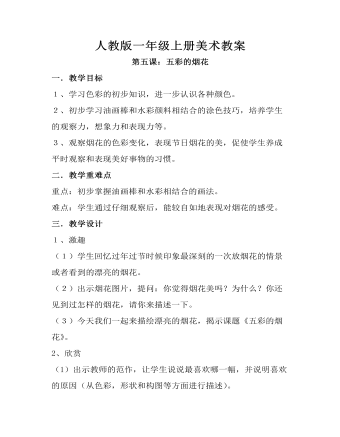
小学美术人教版一年级上册《第5课五彩的烟花》教案
二.教学重难点重点:初步掌握油画棒和水彩相结合的画法。难点:学生通过仔细观察后,能较自如地表现对烟花的感受。三.教学设计1、激趣(1)学生回忆过年过节时候印象最深刻的一次放烟花的情景或者看到的漂亮的烟花。(2)出示烟花图片,提问:你觉得烟花美吗?为什么?你还见到过怎样的烟花,请你来描述一下。(3)今天我们一起来描绘漂亮的烟花,揭示课题《五彩的烟花》。

小学美术人教版一年级上册《第6课美丽的印纹》教案
3.让学生讨论并说说除了手之外,还可以用什么东西来印。三、布置作业1.团结协作;2.注意卫生;3.比一比,哪一组印得最美丽。

初中化学人教版九年级上册《实验活动3燃烧的条件》教案
【学习目标】1.知识与技能:加深对燃烧条件的认识,进一步了解灭火的原理。2.过程与方法:体验实验探究的过程,学习利用实验探究的方法研究化学。3.情感态度与价值观:利用化学知识解释实际生活中的具体问题,使学生充分体会到化学来源于生活,服务于社会。【学习重点】通过物质燃烧条件的探究,学习利用控制变量的思想设计探究实验,说明探究实验的一般过程和方法。【学习难点】利用控制变量的思想设计对照实验进行物质燃烧条件的探究。【课前准备】《精英新课堂》:预习学生用书的“早预习先起步”。《名师测控》:预习赠送的《提分宝典》。情景导入 生成问题1.复习:什么叫燃烧?燃烧条件有哪些?今天自己设计实验来进行探究。2.明确实验目标,导入新课。合作探究 生成能力学生阅读课本P150的相关内容并掌握以下内容。实验用品:镊子、烧杯、坩埚钳、三脚架、薄铜片、酒精、棉花、乒乓球、滤纸、蜡烛。你还需要的实验用品:酒精灯、水。1.实验:用棉花分别蘸酒精和水,放到酒精灯火焰上加热片刻。上述实验中我们能观察到什么现象?说明燃烧需要什么条件?如果在酒精灯上加热时间较长,会发生什么现象?答:蘸酒精的棉花燃烧,蘸水的棉花没有燃烧,说明燃烧需要有可燃物。如果加热时间较长,水蒸发后,蘸水的棉花也会燃烧。2.如图所示,进行实验:我们能观察到什么现象?说明燃烧需要什么条件?答:在酒精灯火焰上加热乒乓球碎片和滤纸碎片,都能燃烧,说明二者都是可燃物。放在铜片两侧给它们加热后可看到乒乓球碎片先燃烧,说明燃烧需要温度达到可燃物的着火点。3.你能利用蜡烛和烧杯(或选择其他用品)设计一个简单实验证明燃烧需要氧气(或空气)吗?答:点燃两支相同的蜡烛,然后在一支蜡烛上扣住一只杯子,看到被杯子扣住的蜡烛一会儿就熄灭,说明燃烧的条件之一是需要氧气。
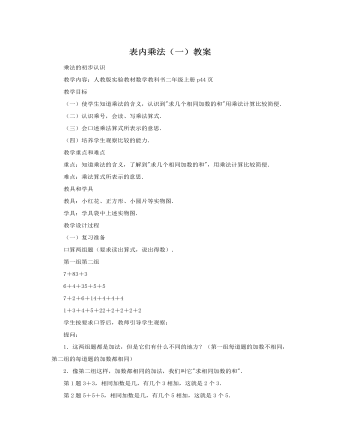
人教版新课标小学数学二年级上册表内乘法(一)教案
(6)交流。6的乘法口诀一共有几句?口诀中的第一个数与算式中的第二个因数相同,表示什么?口诀中的第二个数与算式的第一个因数相同,表示什么?相邻两句口诀的积相差几?哪几句难记一些?你用什么方法记呢?怎样记住"三六十八"、"四六二十四"两句口诀?教师在学生发言的基础上鼓励学生大胆说、想出不同记口诀的方法。(7)应用"做一做"第1题(学生半独立完成):①用6根小棒摆1个六边形;②摆2个六边形要用多少根小棒?你是怎样想的?(想口诀"二六十二"。)③运用所学的口诀口答摆4个、6个、3个、5个六边形所需要向小棒数。"做一做"第2题(独立完成):①将第2题改为填空题,在圆圈内填写正确的积;②口答得数,并说一说所用口诀。
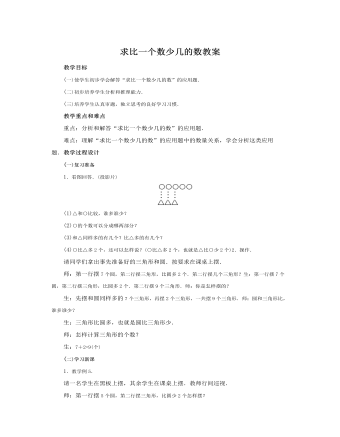
人教版新课标小学数学二年级上册求比一个数少几的数教案
课堂教学设计说明求比一个数少几的数的应用题是低年级教学的一个难点.为了分散难点,在复习准备阶段做了孕伏.如:圆比三角形多2个,也可以说三角形比圆少2个.为了突破难点,让学生动手摆、动口说、动笔写,全方位地调动学生的各种感官参与教学全过程,使学生在参与学习的活动中领悟出“求比一个数少几的数”的应用题仍然是把较大数看作两部分组成的,从大数中去掉大数比小数多的部分,就是小数与大数同样多的部分,也就是小数的数值.也可以通过“假设同样多”去透彻地理解比一个数少几的实际意义.确实使学生理解和掌握了这类应用题用减法计算的道理和解答方法.为了让学生进一步加深理解和掌握“求比一个数少几的数”的应用题的数量关系和解答方法,在巩固练习的最后设计了一组对比题目.
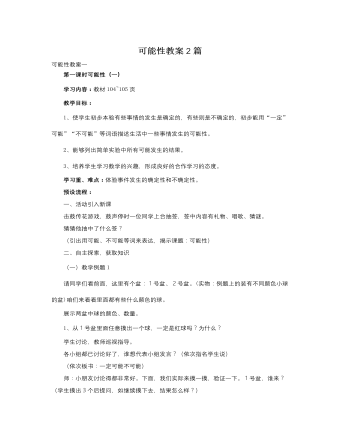
人教版新课标小学数学三年级上册可能性教案2篇
D、师:通过刚才摸球,你认为我们能摸到黄球吗?(能)一定能摸到黄球吗?(不一定)也就是说我们摸到的可能是黄球,也可能是白球。(板书:可能)3、超级竞猜:出示挂图,学生抢答。(课本105页例1)三、拓展应用1、师:在我们生活中同样有很多事情都可以用这些表示可能性的词语来表述。2、完成例2。(1)出示挂图,小组讨论。(2)组织学生汇报交流、评价,你想说哪一幅图的内容就说哪一幅。3、你还能用这些词来说说生活里的事吗?先和同桌交流,然后组织汇报、评价。4、游戏:在三叠卡片中各选一张,按排列顺序组成一句话,说一说这件事发生的可能性。5、作业:在书上完成108页第1、2题。四、总结全课1、师:今天,我们主要学习了什么内容?2、小结:生活里可能性的事情还有很多很多,有些事情一定会发生,有些事情可能会发生,有些事情不可能会发生。希望同学们做生活中的有心人,找一找生活中的可能性。
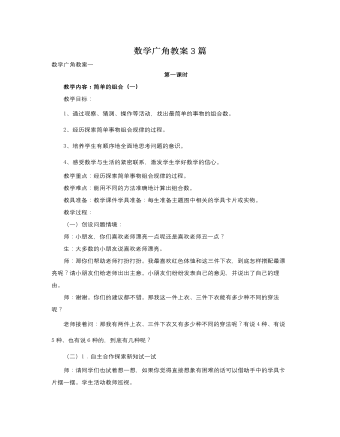
人教版新课标小学数学三年级上册数学广角教案3篇
(一)创设问题情境:师:小朋友,你们喜欢老师漂亮一点呢还是喜欢老师丑一点?生:大多数的小朋友说喜欢老师漂亮。师:那你们帮助老师打扮打扮。我最喜欢红色体恤和这三件下衣,到底怎样搭配最漂亮呢?请小朋友们给老师出出主意。小朋友们纷纷发表自己的意见,并说出了自己的理由。师:谢谢。你们的建议都不错。那我这一件上衣、三件下衣能有多少种不同的穿法呢?老师接着问:那我有两件上衣、三件下衣又有多少种不同的穿法呢?有说4种、有说5种、也有说6种的,到底有几种呢?(二)1.自主合作探索新知试一试师:请同学们也试着想一想,如果你觉得直接想象有困难的话可以借助手中的学具卡片摆一摆。学生活动教师巡视。2.发现问题学生汇报所写个数,教师根据巡视的情况重点展示几份,引导学生发现问题:有的重复了,有的漏写了。
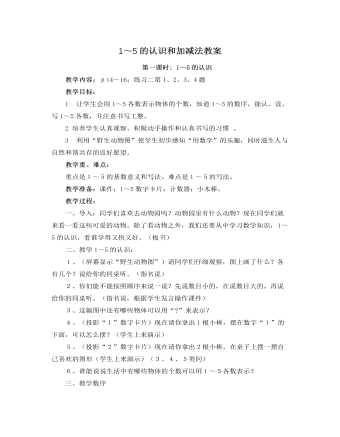
人教版新课标小学数学一年级上册1~5的认识和加减法教案
教学难点:利用数的分解组成,正确地计算5以内的减法。教学准备:小圆片、小棒、小黑板。教学过程:一、复习:1、拍手接力游戏 。2、看图说图意,并列式计算。3、复习5以内数的组成。二、新授:1、(小黑板)出示画图:树上有5只鸟,飞走了一只。根据这幅图,你能提什么问题呢?2、那么你怎么列式呢?先和小组里的小朋友说一说,再指名回答,请学生上来板书列式。3、小组内交流:“5-1”得几?你是怎么算的?和组里的小朋友交流,每个小朋友都说自己的想法,是怎样得出结果的。4、汇报情况:指名小老师上来教大家计算的过程(提倡算法多样化,教师可以有意识请想法不同的学生上来说一说)5、抽象出计算过程:引导学生如果不看图,不数手指,你会计算“5-1”得几吗?(引导学生用数的组成知识来计算)
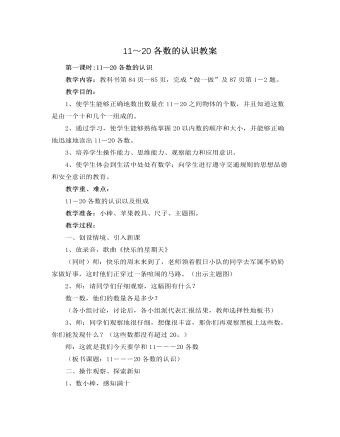
人教版新课标小学数学一年级上册11~20各数的认识教案
教学难点:能用多种方法进行计算。教学准备:计数器、小棒、投影片等。教学过程:一、创设情景(投影出示)在一个美丽的大森林里,一天早上,二只松鼠提着一个篮子上山采松果,松鼠妈妈采了14个,松鼠宝宝采了3个,然后就一起高高兴兴地回家去了。(学生看图,然后让学生根据图意编一个小故事,比一比,看谁编的故事最有趣)1、指名编故事。2、有谁能提出有关的数学问题。(先同桌互相说,然后再指名说)教师根据学生的回答进行选择性的板书:(1)一共有多少个松果?(2)松鼠妈妈比松鼠宝宝多采多少个?(3)松鼠宝宝比松鼠妈妈少采多少个松果?(4)松鼠宝宝还要采多少个才能和松鼠妈妈采的同样多?3、先解决第一个问题:问:(1)要求一共有多少个松果?用什么方法计算?如何列式?为什么用加法计算?说一说你的理由?还有谁能说?(2)14+3=?你是怎样算的?同桌互说算法,然后指名说。
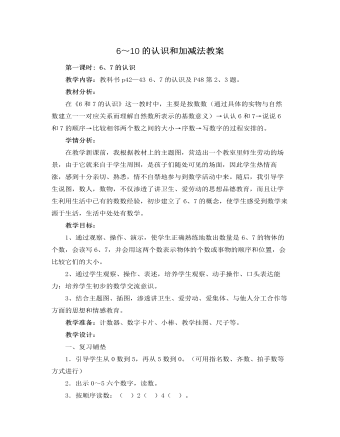
人教版新课标小学数学一年级上册6~10的认识和加减法教案
四、全课总结[设计意图:通过电教媒体把抽象的数学知识与学生的心理和生活中喜欢做游戏的特点结合起来,使学生在乐中学,在玩中学,有利于学生对知识的理解和掌握。]教学反思:根据学生年龄小、活泼好动的特点,我在教学中力求激发学生学习的积极性、主动性,使学生在愉悦和谐的课堂气氛中获取新知,并培养了学生的多种能力。第十五课时: 生活中的数教学内容:教科书第46页、第57页、第87页“生活中的数”。教材分析:本节课教师通过课件演示,创设生活情境,在现实世界中寻找生活素材,成功地将学生的视野拓宽到他们熟悉的生活空间。然后通过说一说、摆一摆、猜一猜、算一算等实践活动,让学生感觉到数学就在他们身边,看得见、摸得着。学生自始至终地参与观察、操作、猜测、验证、思考等多种实践活动,积极性非常高。可以说,我在围绕“数与生活”这一中心设计教学活动时,也在积极地进行构建“生活数学”教学体系的探索与尝试。
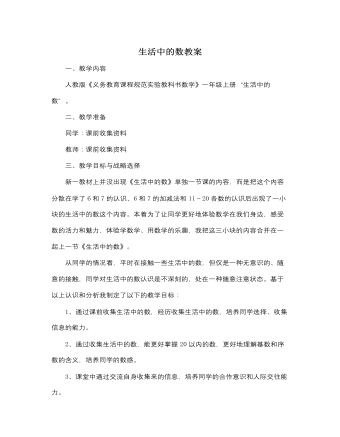
人教版新课标小学数学一年级上册生活中的数教案
六、教学反思 从这节课的实施情况看,课堂实施与原先的公开课教案是比较一致的,效果也是比较好的,主要体现于以下两点: 1、效果得益于“跳出”--跳出教材框框 刚开始备课和试教时,我打算充沛利用教材,根据教材上的内容出示幻灯片让同学说一说,但一节课下来显得很单调、信息量很少,体现不出生活中数的味道。于是我开放教材,跳出教材的框框,课前安排一个“找生活中的数”实践活动把同学放到社会生活之林中去,让他们先找些“野食”吃。这样,课前在准备过程当中积累的素材多了,同学的学习效益大大提高了。同学在丰富多彩的实际生活中自由自在地采撷自身感兴趣的“果子”,他们采来的“果子”是绚丽多姿的,然后回到课堂交流,共享到了“果子”的丰富,起到“以一当数十”的作用。 这个“跳出”战略,体现了现代科学“系统论”的理论。系统论认为:系统只有开放,不时吸收外界的信息,才干使自身“有序”。
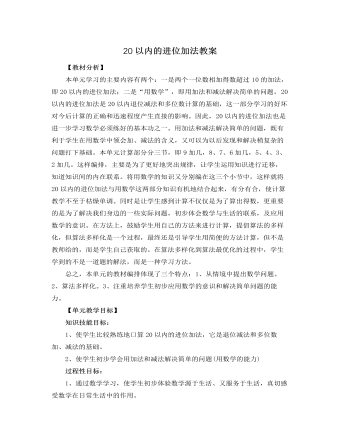
人教版新课标小学数学一年级上册20以内的进位加法教案
教学目标:1、通过多种形式的练习,提高学生的计算速度和正确率。2、培养学生看图表的能力,初步渗透统计思想。3、培养学生学习数学的兴趣,同时培养学生的数感。教学重、难点:熟练掌握计算方法并能够进行正确的计算,能够有效的提高计算速度及正确率教学过程:一、基本练习1、口算10-38+49-1 9-88+215+38+77+55+6 3+911-19+68+86+78+6 9+82+93+102、()里应填什么数?(1)比9大2的数是(),比7多4的数是()。(2)写出得数是13的四道算式?( )、()、( )、()(3)练习9+()=13 8+()=1512-()=2()+7=14()+()=12 ()+()=19二、指导练习练习二十一第4题(1)学生看书,弄清题目的意思。问:这题是什么意思?(2)分组讨论,并派代表说一说。(3)教师板书,引导学生看统计表。指导学生看表:表的第一竖行画有皮球、毽子、跳绳;第二竖行上面写着“一班有”,下面的数就是一班有这三种体育用品的数量,即一班有7个皮球、5个毽子、4条跳绳;
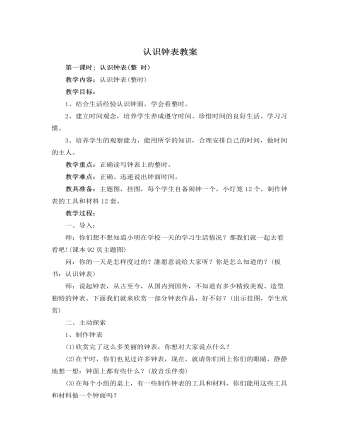
人教版新课标小学数学一年级上册认识钟表教案
二、认识半时1、挂图出示钟面:7时半、8时半师:请小朋友拿出自己的钟,拨一拨这二个钟面上所表示的时刻,你能发现这两个钟面有什么共同的特点吗?2、学生自由回答。教师小结,得出规律:钟面上半时时,分针指着数字6,而时针总是指向两个数字的中间。挂图再出示二个钟面上的表示的时刻,师:你说一说这两个钟面的时刻是多少3、认一认挂图出示图片(即书中第93面的做一做)师:请你说一说图中的小朋友,几时在干什么?4、挂图出示7时、7时半师:请你们认真观察,说一说这两个钟面上表示的时刻,看一看两根指针的位置有什么不同?5、教师小结。三、练习反馈,激活思维1、请你在你的钟上面拨一个你最喜欢的半点时刻,并说一说你为什么最喜欢这个时刻?
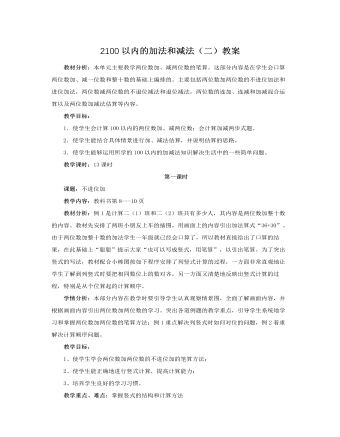
人教版新课标小学数学二年级上册2100以内的加法和减法(二)教案
教材分析:例4是让学生判断妈妈要买三种生活用品,带100元钱够不够。可以结合这种生活中经常出现的情景,使学生认识到,在日常生活中,有时需要进行精确计算,有时根据实际的需要只要估算出大致的结果就可以了,便于学生更完整、全面、深刻地认识数学的功能。估算的策略是多样化的,可以用连加,也可以用连减,还可以用加减混合,中间包含了加法的估算和减法的估算。教材上呈现了两种估算策略,有一名学生用连减的方法先估算出100-28大约得70,再估算出70-43大约得30,从而判断用剩下的钱买水杯还够,两步计算中都运用了估算。另一名学生先用加法估算出28+43大约得70,再口算出大约还剩30元,从而得出买水杯还够的结论,第一步计算运用了估算,第二步是精确计算。由于每个个体的思维方式和思维水平不同,所采取的估算策略也是不同的,教材上除了提供这两种估算策略以外,还有一名学生提出问题:“还可以怎样算呢?”提示教师在教学时让学生灵活采用适合自己的估算方法,体现了算法多样化的思想。
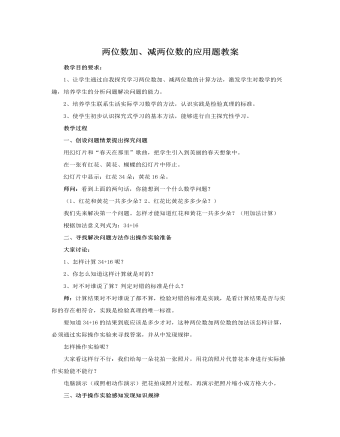
人教版新课标小学数学二年级上册两位数加、减两位数的应用题教案
1、试验性操作实验师:大家说红花的照片能不能用方格代表?下面请同学们用方格代表红花的照片,用我们的学具卡片摆出红花的朵数。(学生操作,教师巡视。)师:大家说黄花的朵数能不能也可以这样操作出?请同学们用上面的方法再操作出黄花的朵数。(学生操作)师:同学们已经摆出了红花的朵数和黄花的朵数,怎么操作才能知道红花和黄花一共是多少朵?(把红花的朵数和黄花的朵数合并起来数一数)(学生操作,教师巡视。)师:请把合并起来的数整理一下,让人一看就能知道是多少朵好吗?请同学们写出算式的答案。(即操作表达式)教师多媒体演示全部操作实验过程,并简单小结。2、验证性操作实验师:同学们,假如红花是56朵,黄花是38朵,求“红花和黄花共几朵?”你们还能不能用上面的操作实验方法来解决?(能)好!那就请你们试试看。(学生操作,教师巡视。)
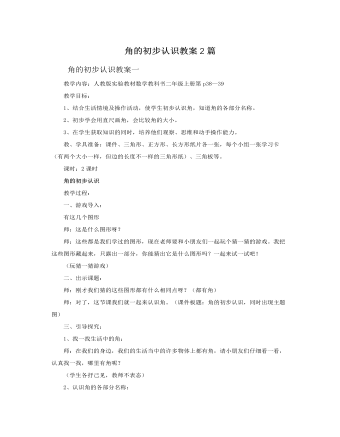
人教版新课标小学数学二年级上册角的初步认识教案2篇
【课中安排学唱《可爱的角》这首歌曲,旋律是学生熟悉并喜爱的,加上简明扼要的歌词和动作,提高了孩子们的兴趣。】四、课堂活动(课件出示)1.辨角。用你火眼金睛找出哪些是角?哪些不是角?为什么?(练习八的第1题)【在学生对角建立起概念的前提下,让学生做该练习,从而加深了学生对角的认识,增强分析、判断能力。这个练习可以叫它“跟随”练习,即刚学会一个新的概念,认识一个新的内容之后,紧跟着的一个比较容易的以选择和判断为主的练习。】2.数角(练习八的第2题)。师:小马看见小朋友们都认识了角,非常高兴,看看天色不早了,赶紧赶路,跑了一会儿,看见图形王国里面有许多图形,但小马不知道各有几个角?小朋友们能帮助它数一数吗?【这是一道“巩固”练习,让学生将所学知识做一次运用,难度稍加大,但学生能做出来,并且能找到练习中的规律,能享受到一种成就感。】
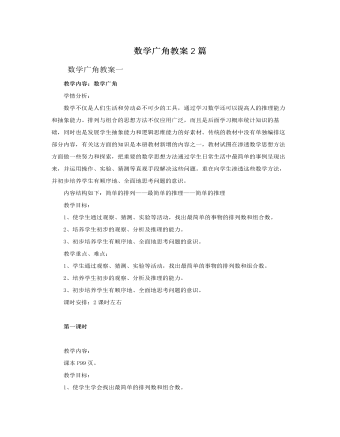
人教版新课标小学数学二年级上册数学广角教案2篇
方法三:我先把数字1放在个位,然后把数字2和3分别放在十位组成21和31;我再把数字2放在个位,然后把数字1和3分别放在十位组成12和32;我再把数字3放在个位,然后把数字1和2分别放在十位组成13和23,一共摆出了6个两位数。(21、31、12、32、13、23)每种方法说完后师问:还能摆吗?(再摆就要重复了!提示:不能遗漏也不能重复)师小结:排数的时候按照一定的顺序既不会重复也不会遗漏。我们用3个不同的一位数拼成了几个不同的两位数?(板书:6个)可拓展:三只动物抽到卡片后最多能组成21、31、32那谁可以和聪聪一起坐呀?小猫很幸运,他抽到了2和3,那么他一定会摆出一个……(三)握手小动物们谢谢我们帮他们一起解决了这些数学问题,一定要让老师表示谢意,好谢谢你们。(老师过去和学生握手。分别找几个人握手,让学生观察,每两个人握一次手。)

